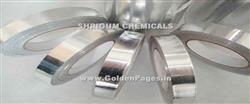SHRIOUM CHEMICALS
Featured Products
Highest quality standards are achieved through the implementations of latest technology, decades of experience and everlasting moral values , which have helped us to retain our customers as well as multiply them.
Welcome to SHRIOUM CHEMICALS
Stainless Steel Passivation

The process specified is to "pickle and passivate" - a two step method - in order to create a surface on stainless steel that would be resistant to corrosion. Pickling (or Chemical Descaling) is done to remove scale and open active surface for Passivation
. Passivation is done to make the surface more passive and corrosion resistant by loosing its chemical reactivity. Passivation unipotentializes the stainless steel with the oxygen absorbed by the metal surface, creating a monomolecular oxide film. Passivation is the formation of a hard non-reactive surface film that inhibits further corrosion. This layer is usually an oxide or nitride that is a few atoms thick.
Passivation is performed when free iron, oxide scale, rust, iron particles, (free ferrite contamination ) metal chips or other nonvolatile deposits might adversely affect the metallurgical or sanitary condition or stability of the surface (corrosion suseptiblity), the mechanical operation of a part, component or system, or contaminate the process fluid.
Passivation is performed on clean stainless steel, providing the surface has been thoroughly cleaned , degassed ( confirm by ASTM approved water droplet test) and descaled.
Since the term "passivation" is used to describe distinctly different operations or processes relating to stainless steels, it is necessary to define precisely what is meant by passivation.
Passivation is the process by which stainless steel will spontaneously form a chemically inactive surface when exposed to air or other oxygen-containing environments. Steels containing more than 11% Chromium are capable of forming an invisible, inert or passive, self-repairing oxide film on their surface. It is this passive layer that gives stainless steels their corrosion resistance. again If a stainless steel surface is scratched, then more Chromium is exposed which reacts with oxygen allowing the passive layer to reform. However, if a particle of carbon steel or tool steel is embedded in the scratch then the passive layer cannot reform and corrosion will occur when the metal is wetted or exposed to a corrosive environment.
This is necessary because during handling and processing such as rolling, forming, machining, pressing, tumbling, and lapping, particles of iron or tool steel or abrasive particles may be embedded in or smeared on or into the surfaces of stainless steel components. If allowed to remain, these particles may corrode and produce rust spots, Tea Staining and yellowing on the stainless steel. This is due to the formation of a galvanic couple between two dissimilar metals that can promote a corrosive reaction. To dissolve the embedded or smeared iron and prevent this condition, as well as restore the original corrosion-resistant surface, semi-finished or finished parts are given a 'passivation' treatment.
Products :
PassiPick Pool TM
PassiPick GelTM
Our Vision
* To embrace new technologies and methods. * To give unsurpassed products and services to the clients. * To constantly look for improvement and changes.









